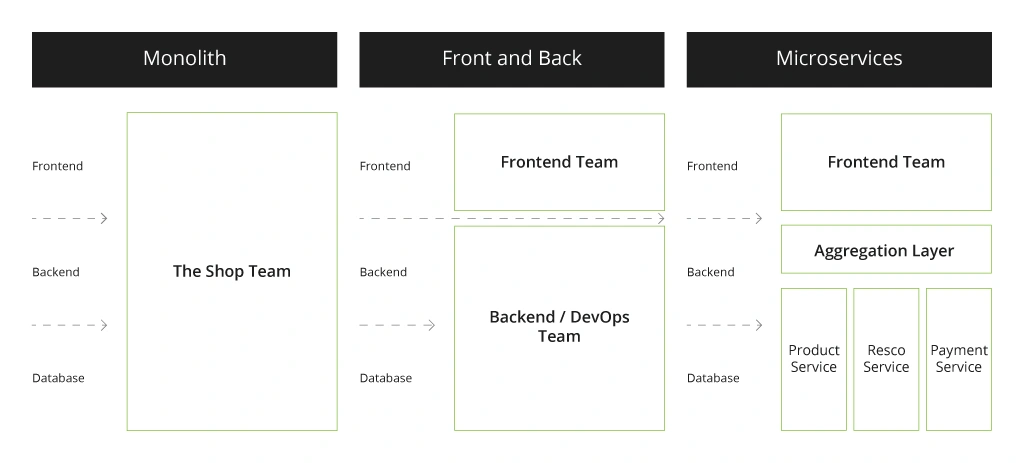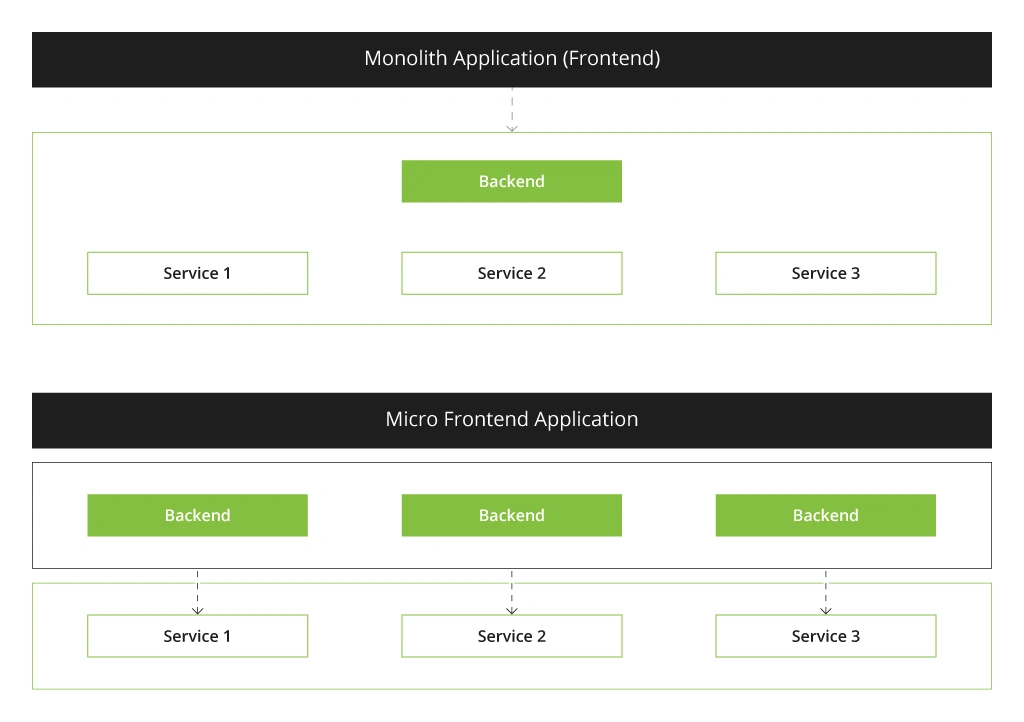Reasons Why Companies Implement a Micro Frontend Architecture
In any development, engineers are looking for different ways to make the process more efficient. That is how the microservice-based approach came along. Developers started to divide software into small, manageable chunks to build, test, and deploy various services independently — on the backend side.
Later on, the same method was implemented for the frontend, and here is how the notion of “a micro frontend architecture” came to life. Namely, it is “an architectural style where independently deliverable frontend applications are composed into a greater whole.”
The trend for micro frontends has started gaining traction. First, this topic is now widely being discussed by industry experts at related conferences. Second, micro frontends are being adopted by many companies, including Netflix, PayPal, and Amex.
Micro Frontends vs Monoliths
Micro frontends are constructed in a standalone, compartmentalized way that is opposed to traditional monolithic architectures. The difference between them is clear. When the software is monolithic, a single team works on its development and maintenance — sharing the codebase as well as monolithic frontend and backend.

In microservices-based development, the backend evolves into a more scalable architecture, where different teams independently work on separate software chunks.
The bottleneck arises when micro backends are integrated into a monolithic frontend. To wit, you cannot make expedient corrections to any changes needed without affecting the entire application, and any modification in the frontend code must be re-implemented, which in turn significantly increases the compilation time.
To deal with this problem, engineers started leveraging the vertical approach to development that presupposes using a less complex architecture based on micro frontends. By dividing the software into standalone functions and implementing them simultaneously, teams get much more efficiency and control over application development and maintenance.

Micro frontends guarantee rock-solid scalability, flexibility, and adaptability, making the solution more user-friendly and less cumbersome.
Key Benefits of Micro Frontends
We have already mentioned some of the advantages of micro frontends in development. Let’s delve into the details.
Autonomous Development
When using large codebases in monolithic frontends, you might find yourself in a counterproductive standstill. Specifically, you can hardly work effectively on a particular software function or update the whole application without the risk of negatively affecting the rest of the codebase.
Conversely, with micro frontends, you can form individual teams responsible for smaller, self-contained microapps who are fully authorized to update the solution — without the need for multiple approvals from managers.
Accelerated Time to Market
Smaller, independent teams have better interaction as opposed to larger ones that might have productivity hampered by communication overhead. Better interaction means more effective work on different software features, faster application updates, and faster time to market.
Increased Scalability
Micro frontends allow development teams to move faster — growing operations and independently releasing particular functions of the software is accelerated.
And as there is no hassle around implementing new, cutting-edge capabilities, you get a highly scalable, robust micro frontend architecture that addresses all the specific needs of your company and your end users.
Easier Maintenance
With smaller codebases and self-contained capabilities, teams spend less time and effort maintaining the frontend, which translates to more resources being available for improving the overall experience for the end users of your software.
Technology Agnosticism
By working independently on each micro frontend and designing self-contained applications, teams can harness a wide variety of technologies and frameworks — picking up the best of the best.
In addition, micro frontends are adaptive to change, so you will not have any problems when implementing up-and-coming tech innovations over time — helping you conquer your most daunting business needs.
A case in point: Infopulse leveraged the micro frontend-based approach, DevOps best practices, and other cutting-edge technologies to build a robust IoT app that helped our client revamp office space management and enhance employee productivity, all while slashing costs.
In other words, smaller codebases and modular micro apps make all these changes faster and less labor-intensive, without any impact to other applications within your frontend architectures.
Greater Consistency
By leveraging micro frontends and their shared interfaces and capabilities, you provide your end users with better consistency and continuity across application touchpoints — despite micro frontends' moving elements.
Furthermore, with smooth micro frontend architecture updates, you can quickly address users’ ever-changing needs.
A case in point: Infopulse leveraged a modular architecture to build a user-friendly application for an Irish education company. The solution has a customized look and feel that aligns with the company’s branding, and its end users can now easily perform instant, accurate online payments available on-the-go.
Functionality Reuse
If you are working on several solutions with common workflow requirements, micro frontends will be more than beneficial. Why? Because developers can reuse common functionalities for new applications, thus saving time, effort, and money. Payment processing, registration, email notifications — these and other features can be smoothly reused several times over instead of being created from the ground up each time.
Faster Application Testing
In monolithic headframes, when you introduce even tiny changes, you need to run tests across the entire solution. And this means more time spent on the quality assurance process and probable disruptions in developers’ and engineering leaders’ work.
With micro frontends, you zero out the possibility of this problem — by testing standalone micro apps. Even if some complications occur, with such isolated testing in place the impact will be limited to the specific microapp, not the entire frontend.
Micro Frontend Implementation: Who Benefits?
Considering all the above-mentioned advantages of micro frontends, it becomes clear that everyone in the development chain benefits from this approach.
Application developers leverage faster development cycles, lower maintenance demands, and decreased complexity when introducing changes. With micro frontends at hand, it is easier for them to ensure continuous delivery and more optimized micro journeys.
Team leads and managers, therefore, enjoy easier and more productive workflows. Instead of constantly overseeing development teams (the ordinary thing in monolith-based engineering), they can focus on more value-added tasks — such as communication, microapp reuse, efficiency maximization, process optimization, and more.
As for company executives, benefits like long-term development and QA cost savings due to testing separate micro apps will not be long in coming. Moreover, business leaders can rely on scalable micro frontends for pursuing their business growth goals.
If you want to enhance end-user engagement, ensuring a user-friendly interface is a must. With a modular architecture, you will be able to create multi-experience user journeys, helping developers deliver consistent, engaging, and more personalized customer experiences.
What Are Micro Frontend Challenges?
In any development method — no matter how many benefits you receive — there is always the reverse side to factor in.
As for micro frontends, you might face the following drawbacks:
- UX fragmentation. Team independence is great in terms of development speed and efficiency, but it might affect styling, resulting in your solution looking inconsistent and composed of numerous chunks that are not as seamless or harmonious as they should be. To avoid this possibility, create firm UI and UX guidelines at the early stages of the build and strengthen collaboration across your teams.
- Poor performance. Every particular microapp requires substantial resources — including CPU, RAM, and network bandwidth — and this might slow down the whole solution. To prevent such performance glitches, avoid making the same API calls and elaborations as well as communication before implementing a heavy operation. Store the results of all these calls and elaborations in a single, accessible location for every team in place. Also, when conducting performance testing, test the whole application, not each micro frontend in particular.
- Frontend miscommunication. Frontend independence is one of the key benefits of development with micro frontends. However, as your solution grows, this might become a challenge, forcing you to enhance cross micro frontend communication through props and customized events.
Final Thoughts
Micro frontend benefits are as clear as a bell, and reasons to leverage self-contained apps are numerous. However, before proceeding to micro frontend implementation, be ready to perform a cost-benefit analysis. This is essential to specify both business and cost advantages as well as gauge the ROI of your particular development project.
To make this process easier and more efficient, partner with a reliable software development company. An experienced developer will thoroughly analyze your business case and come up with a highly personalized strategy, covering risk minimization and TCO optimization.
![Micro Frontend Architecture [Open Graph]](https://www.infopulse.com/uploads/media/banner-1920x528-reasons-why-companies-implement-a- micro-frontend-architecture_1.webp)

![Power Apps Licensing Guide [thumbnail]](/uploads/media/thumbnail-280x222-power-apps-licensing-guide.webp)
![How to Build Enterprise Software Systems [thumbnail]](/uploads/media/thumbnail-280x222-how-to-build-enterprise-software-systems.webp)
![Super Apps Review [thumbnail]](/uploads/media/thumbnail-280x222-introducing-Super-App-a-Better-Approach-to-All-in-One-Experience.webp)
![ServiceNow and Third-Party Integrations [thumbnail]](/uploads/media/thumbnail-280x222-how-to-integrate-service-now-and-third-party-systems.webp)
![Cloud Native vs. Cloud Agnostic [thumbnail]](/uploads/media/thumbnail-280x222-cloud-agnostic-vs-cloud-native-architecture-which-approach-to-choose.webp)
![DevOps Adoption Challenges [thumbnail]](/uploads/media/thumbnail-280x222-7-devops-challenges-for-efficient-adoption.webp)
![White-label Mobile Banking App [Thumbnail]](/uploads/media/thumbnail-280x222-white-label-mobile-banking-application.webp)

![Mortgages Module Flexcube [Thumbnail]](/uploads/media/thumbnail-280x222-Secrets-of-setting-up-a-mortgage-module-in-Oracle-FlexCube.webp)
![Challenges in Fine-Tuning Computer Vision Models [thumbnail]](/uploads/media/thumbnail-280x222-7-common-pitfalls-of-fine-tuning-computer-vision-models.jpg)